Protein Engineering Market Size
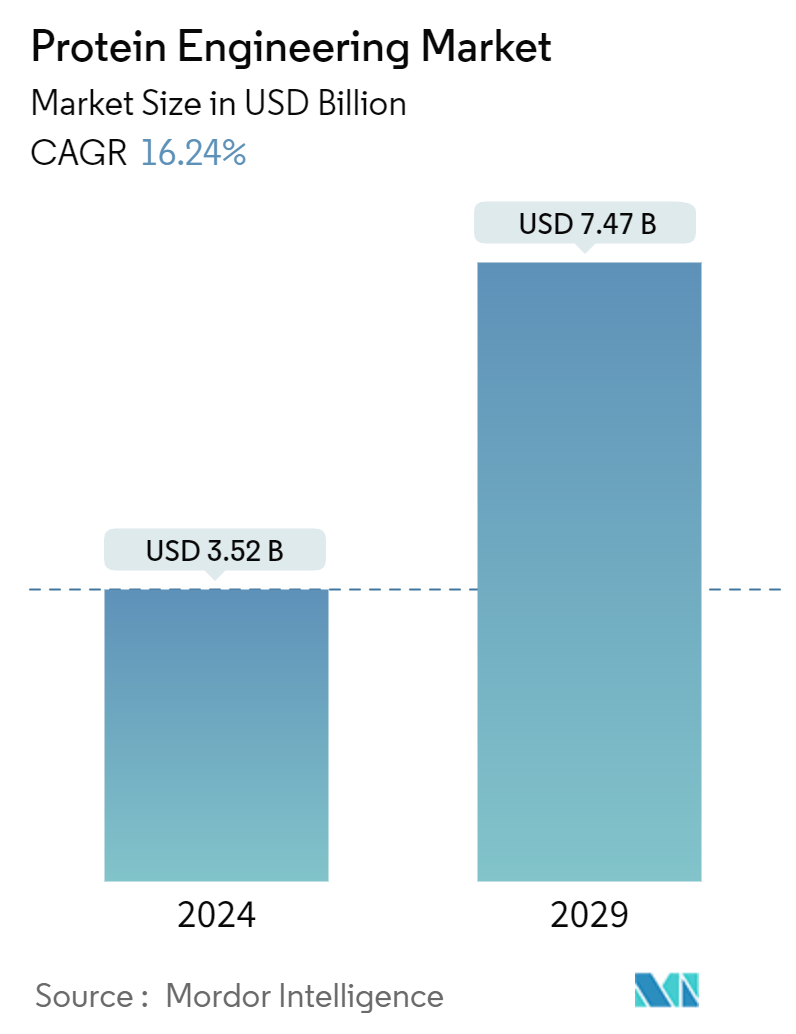
| Study Period | 2019 - 2029 |
| Market Size (2024) | USD 3.52 Billion |
| Market Size (2029) | USD 7.47 Billion |
| CAGR (2024 - 2029) | 16.24 % |
| Fastest Growing Market | Asia Pacific |
| Largest Market | North America |
Major Players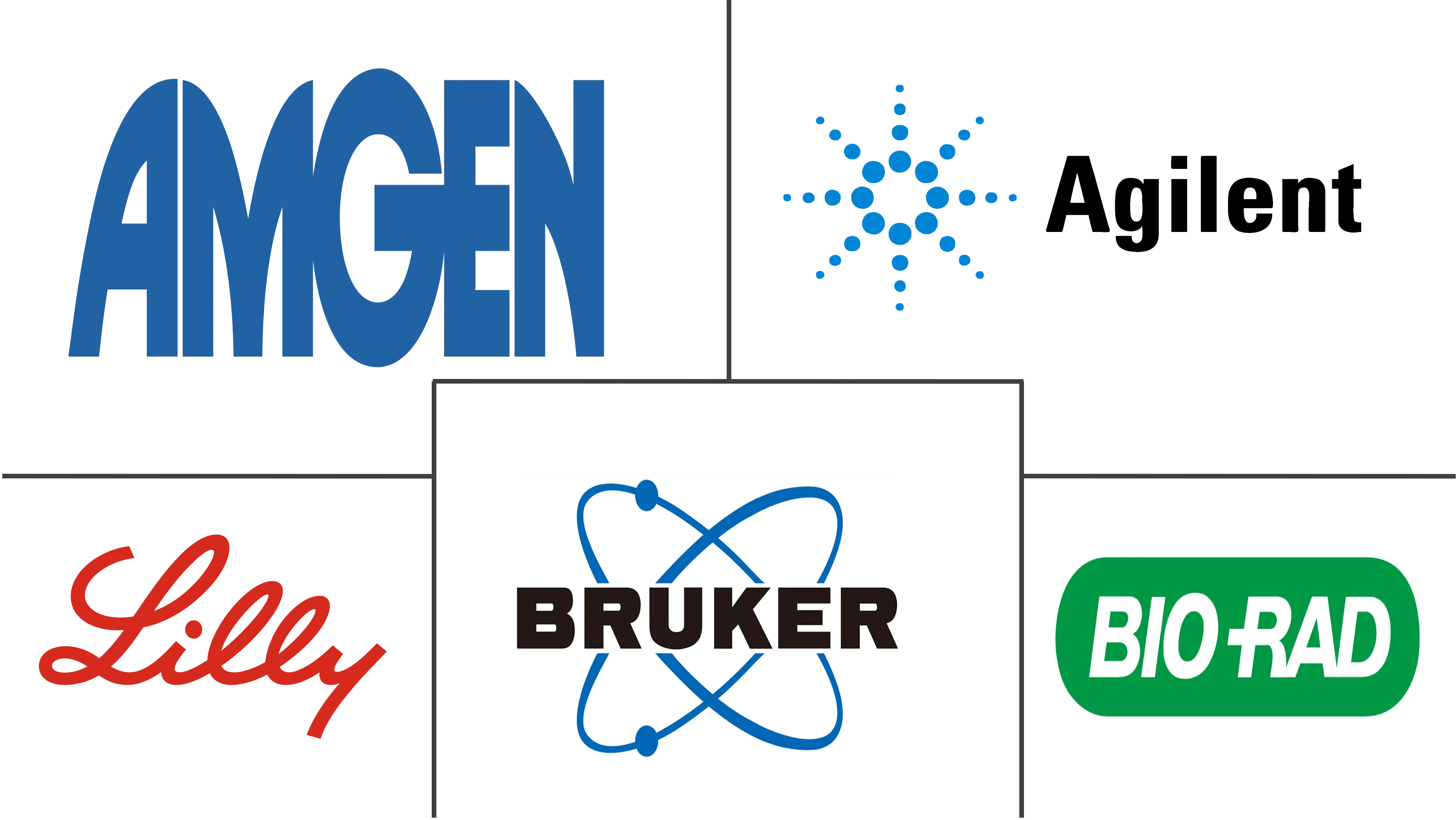
*Disclaimer: Major Players sorted in no particular order |
Protein Engineering Market Analysis
The Protein Engineering Market size is estimated at USD 3.52 billion in 2024, and is expected to reach USD 7.47 billion by 2029, growing at a CAGR of 16.24% during the forecast period (2024-2029).
The propelling factors for the growth of the protein engineering market include the increase in chronic diseases, the rise in demand for targeted therapies, and rising government funding for protein engineering studies. For instance, an article published in April 2023 in the Journal of the Advanced Practitioner in Oncology mentioned the advantages of targeted therapy for improving the response and survival rate among cancer patients. It was observed that the targeted therapy helped oncologists personalize cancer therapy and enhance patient outcomes. Thus, the demand for protein engineering is expected to increase as the use of engineered proteins for targeted drug activation enhances the control of pharmacokinetics and pharmacodynamics and reduces side effects. Such factors are anticipated to propel market growth over the forecast period.
The increasing prevalence of chronic diseases such as cancer fuels the demand for protein-engineered therapies that recognize different molecular targets to regulate the related signaling pathways and kill tumor cells. For instance, according to the 2024 updated data published by the American Cancer Society, around 20 million cancer cases have been diagnosed worldwide, and it is projected to reach 35 million by 2050. Thus, the expected increase in cancer cases is expected to raise the need for effective therapies, which is anticipated to boost the growth of the protein engineering market over the forecast period.
Furthermore, new product launches and collaborative strategies adopted by key players are anticipated to fuel the demand for protein engineering to develop protein-based therapies, propelling market growth. For instance, in April 2023, Swiss Adaptyv Biosystems Sàrl launched two fast-feedback tools that allow cheap, rapid, and miniaturized validation of AI-designed proteins. The new tool is intended to open the way for protein designers to develop new medicines, novel enzymes, and sustainable materials. Similarly, in January 2022, Amgen and Generate Biomedicines entered a research collaboration to discover and create protein therapeutics for five clinical targets across several therapeutic areas and multiple modalities. Hence, the increasing number of strategic activities by key players for efficient protein engineering research helps drive the market's overall growth.
Therefore, factors such as the increasing prevalence of chronic diseases, the growing demand for targeted therapies, and strategic initiatives by key players contribute to market growth. However, the high costs of protein engineering techniques are likely to restrain market growth over the forecast period.
Protein Engineering Market Trends
The Monoclonal Antibodies Segment is Anticipated to Witness Notable Growth Over the Forecast Period
Monoclonal antibodies are used to diagnose and treat many diseases, including cancers. The monoclonal antibodies segment is anticipated to hold a significant market share over the forecast period, owing to their high adoption for novel therapies, such as cancer and autoimmune diseases, and the increase in product launches coupled with various strategic activities adopted by key market players.
The increasing burden of chronic diseases raises the need for monoclonal antibodies and is anticipated to contribute to market growth. For instance, in August 2023, as per the data published by the Australian Institute of Health and Welfare (AIHW), about 165,000 cancer cases were diagnosed in Australia in 2023. Additionally, in September 2023, the Asthma and Allergy Foundation of America mentioned that around 27 million individuals in the United States were affected by asthma. Thus, the high prevalence of chronic diseases such as cancer and asthma is expected to favor the adoption of monoclonal antibody therapeutics, which is anticipated to contribute to the segment's growth.
Various monoclonal antibody therapies are found to be effective in treating cancer and, thus, are anticipated to drive market growth. For instance, as per an article published in February 2022 in Nature Journal, monoclonal antibodies are a promising class of targeted anticancer medicines that improve the functioning of the body's immune system to inhibit the growth and spread of cancer cells. The creation of numerous therapeutic antibodies, including antibody fragments, bispecific antibodies, and antibody derivatives, has been sparked by the successful use of IgG monoclonal antibodies (e.g., antibody-drug conjugates and immune cytokines). Thus, the significance of monoclonal antibodies for cancer treatment raises its adoption, which is expected to boost segment growth over the forecast period.
Moreover, the increasing company activities, such as new product launches for developing protein-engineered drugs for treating various diseases, are likely to increase the demand for protein-based therapeutics, which is expected to augment market growth. For instance, in September 2023, KBI Biopharma Inc. launched SUREmAb, a vertically integrated global offering built on KBI’s SUREtechnology platform for optimized, safe, and cost-efficient monoclonal antibody (mAb) development and manufacturing. Similarly, in October 2022, the Food and Drug Administration granted accelerated approval to teclistamab (Tecvayli) to treat some people with multiple myeloma. The approval, based on the results of the MajesTEC-1 trial, is for adults with multiple myeloma who have come back after at least four prior lines of treatment.
Therefore, the increasing product launches and rising prevalence of cancer and autoimmune diseases among the population are likely to boost segment growth, thereby propelling market growth over the forecast period.
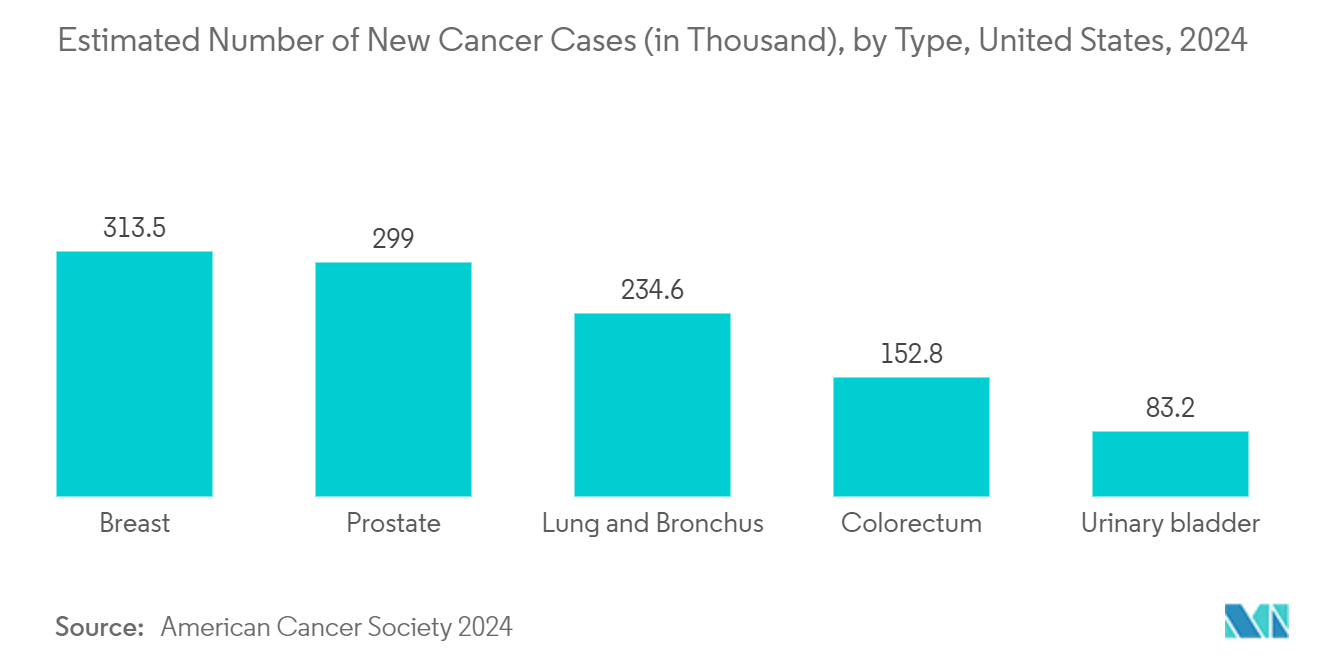
North America is Anticipated to Hold a Significant Market Share Over the Forecast Period
North America is expected to witness significant growth in the protein engineering market owing to factors such as the rising incidence of chronic diseases, supportive government policies, high healthcare spending, and increasing adoption of protein drugs over non-protein drugs.
The rise in chronic diseases in North America is anticipated to propel the demand for protein-engineered therapies and will likely boost market growth. For instance, in November 2023, according to an article published by the American Diabetes Association, around 1.2 million new cases of diabetes are diagnosed every year in the United States. Thus, the growing burden of diabetes among the population is likely to increase the demand for insulin, further increasing the demand for protein-engineered artificial insulin, thereby boosting market growth.
Additionally, according to the data published by the Canadian Cancer Society in November 2023, an estimated 239,100 Canadians were diagnosed with cancer during 2023, and around 45% of individuals in Canada are expected to be diagnosed with cancer in their lifetime. Further, according to the International Agency for Research on Cancer, the prevalence of cancer cases in Mexico was anticipated to increase from 207 thousand cases in 2022 to 255 thousand cases in 2030. Hence, the high incidence of cancer cases is expected to raise the demand for protein drugs and treatments, which is anticipated to positively impact the growth of the protein engineering market over the forecast period.
Moreover, key market players focusing on developing protein engineering products, such as vaccines and drugs, are engaging in strategic collaborative activities that are likely to boost the market's growth. For instance, in March 2024, Samsung Biologics collaborated with BrickBio Inc. to develop advanced molecules and therapies by deploying protein engineering technology for antibody-drug conjugates. Thus, such initiatives being adopted by market players to develop novel products are anticipated to drive market growth in the United States.
Therefore, the rising burden of chronic diseases and increasing product approvals in North America are projected to boost the market's growth over the forecast period.
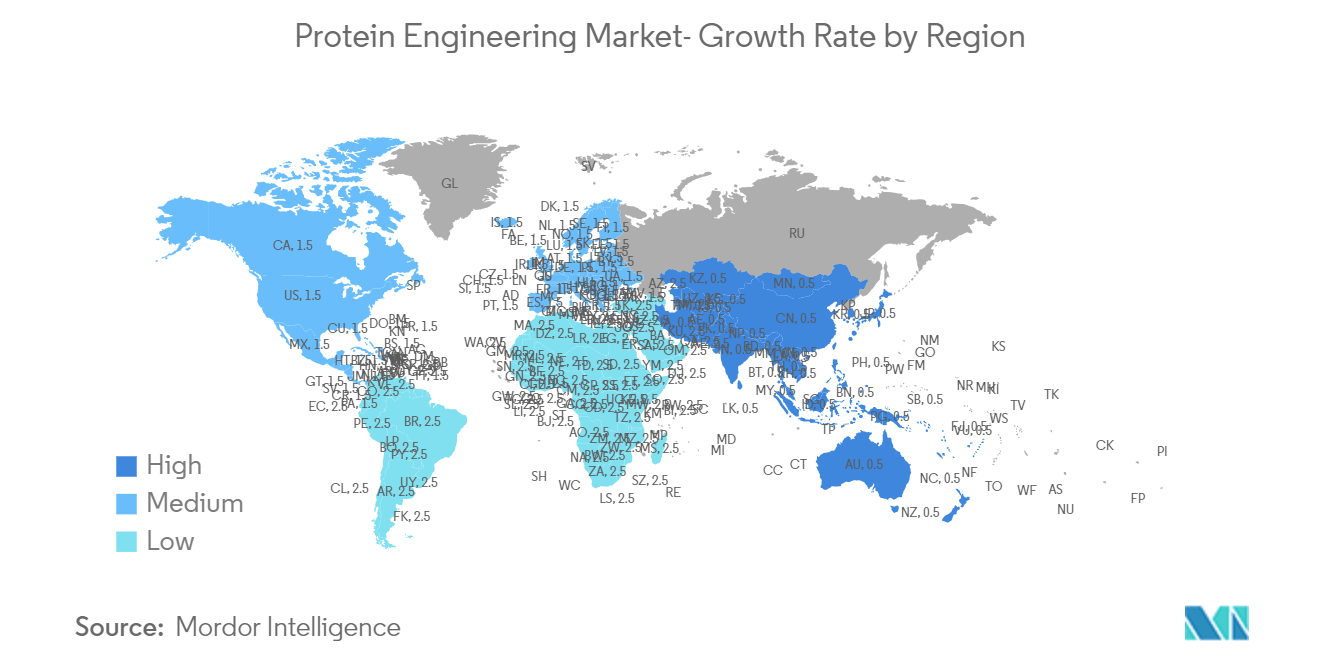
Protein Engineering Industry Overview
The protein engineering market is partially fragmented in nature, and the key players are highly focused on strategies, such as mergers and acquisitions, new product development initiatives, and geographical expansion, to retain their market position. Some of the market players include Amgen Inc., Bruker Corporation, Bio-Rad Laboratories Inc., Agilent Technologies Inc., Eli Lilly and Company, and Merck KGaA.
Protein Engineering Market Leaders
-
Amgen Inc.
-
Bio-Rad Laboratories Inc.
-
Agilent Technologies Inc.
-
Eli Lilly and Company
-
Bruker Corporation
*Disclaimer: Major Players sorted in no particular order
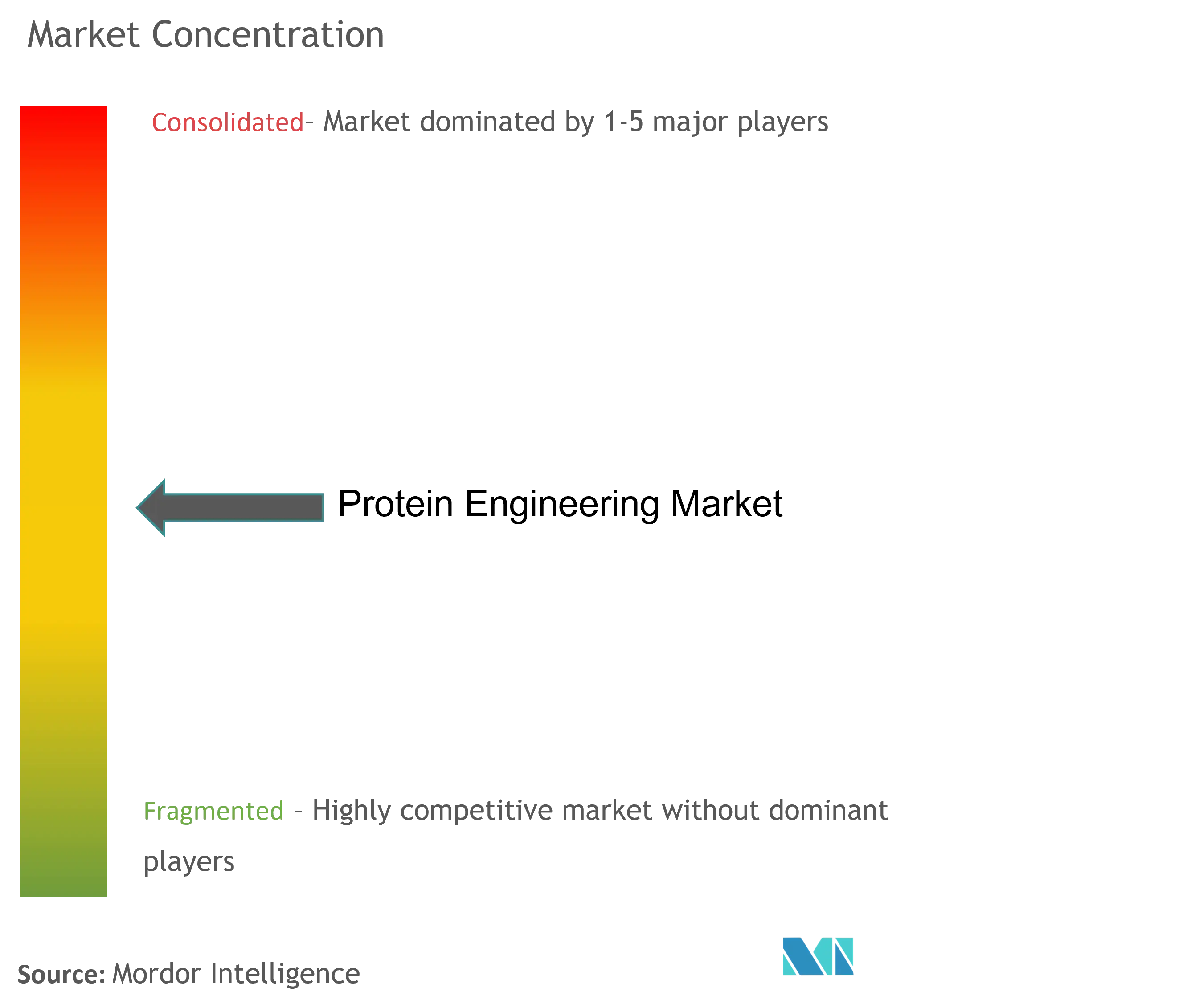
Protein Engineering Market News
- April 2024: Northpond-funded Laboratory for Bioengineering Research and Innovation made an investment with the Wyss Institute for the AmnioX project to facilitate the development of protein-based drugs, thus improving the accessibility of medicines to patients.
- March 2023: Arzeda collaborated with Takeda to leverage artificial intelligence-based protein design technology to boost the optimization of protein biologics. This collaboration is likely to enhance therapeutic protein development and its products.
Protein Engineering Market Report - Table of Contents
1. INTRODUCTION
- 1.1 Study Assumptions and Market Definition
- 1.2 Scope of the Study
2. RESEARCH METHODOLOGY
3. EXECUTIVE SUMMARY
4. MARKET DYNAMICS
- 4.1 Market Overview
-
4.2 Market Drivers
- 4.2.1 Increasing Prevalence of Chronic Diseases and Rise in Demand for Targeted Therapies
- 4.2.2 Rising Government Funding for Protein Engineering Studies
-
4.3 Market Restraints
- 4.3.1 High Costs of Protein Engineering Techniques
-
4.4 Porter's Five Forces Analysis
- 4.4.1 Bargaining Power of Suppliers
- 4.4.2 Bargaining Power of Buyers/Consumers
- 4.4.3 Threat of New Entrants
- 4.4.4 Threat of Substitute Products
- 4.4.5 Intensity of Competitive Rivalry
5. MARKET SEGMENTATION (Market Size by Value - USD)
-
5.1 By Product Type
- 5.1.1 Insulin
- 5.1.2 Monoclonal Antibodies
- 5.1.3 Coagulation Factors
- 5.1.4 Vaccines
- 5.1.5 Growth Factors
- 5.1.6 Other Product Types
-
5.2 By Technology
- 5.2.1 Irrational Protein Design
- 5.2.2 Rational Protein Design
-
5.3 By End User
- 5.3.1 Pharmaceutical and Biotechnology Companies
- 5.3.2 Academic Institutions
- 5.3.3 Contract Research Organizations
-
5.4 Geography
- 5.4.1 North America
- 5.4.1.1 United States
- 5.4.1.2 Canada
- 5.4.1.3 Mexico
- 5.4.2 Europe
- 5.4.2.1 Germany
- 5.4.2.2 United Kingdom
- 5.4.2.3 France
- 5.4.2.4 Italy
- 5.4.2.5 Spain
- 5.4.2.6 Rest of Europe
- 5.4.3 Asia-Pacific
- 5.4.3.1 China
- 5.4.3.2 Japan
- 5.4.3.3 India
- 5.4.3.4 Australia
- 5.4.3.5 South Korea
- 5.4.3.6 Rest of Asia-Pacific
- 5.4.4 Middle East and Africa
- 5.4.4.1 GCC
- 5.4.4.2 South Africa
- 5.4.4.3 Rest of Middle East and Africa
- 5.4.5 South America
- 5.4.5.1 Brazil
- 5.4.5.2 Argentina
- 5.4.5.3 Rest of South America
6. COMPETITIVE LANDSCAPE
-
6.1 Company Profiles
- 6.1.1 Agilent Technologies Inc.
- 6.1.2 Amgen Inc.
- 6.1.3 Bruker Corporation
- 6.1.4 Bio-Rad Laboratories Inc.
- 6.1.5 Eli Lilly and Company
- 6.1.6 Merck KGaA
- 6.1.7 Novo Nordisk AS
- 6.1.8 PerkinElmer Inc.
- 6.1.9 Thermo Fisher Scientific Inc.
- 6.1.10 Waters Corporation
- 6.1.11 GenScript Biotech Corporation
- 6.1.12 GE HealthCare
- *List Not Exhaustive
7. MARKET OPPORTUNITIES AND FUTURE TRENDS
** Subject To AvailablityProtein Engineering Industry Segmentation
As per the scope of the report, protein engineering is the method in which the structures of proteins are modified to produce the desired properties or synthesize proteins with particular structures. The development of valuable proteins for the treatment of diseases such as cancer enhances their stability and enzymatic activity.
The protein engineering market is segmented by product type, technology, end user, and geography. By product type, the market is segmented into insulin, monoclonal antibodies, coagulation factors, vaccines, growth factors, and other product types. By technology, the market is segmented into irrational protein design and rational protein design. By end users, the market is segmented into pharmaceutical and biotechnology companies, academic institutions, and contract research organizations. By geography, the market is segmented into North America, Europe, Asia-Pacific, the Middle East and Africa, and South America. For each segment, the market size is provided in terms of USD value.
| By Product Type | Insulin | |
| Monoclonal Antibodies | ||
| Coagulation Factors | ||
| Vaccines | ||
| Growth Factors | ||
| Other Product Types | ||
| By Technology | Irrational Protein Design | |
| Rational Protein Design | ||
| By End User | Pharmaceutical and Biotechnology Companies | |
| Academic Institutions | ||
| Contract Research Organizations | ||
| Geography | North America | United States |
| Canada | ||
| Mexico | ||
| Geography | Europe | Germany |
| United Kingdom | ||
| France | ||
| Italy | ||
| Spain | ||
| Rest of Europe | ||
| Geography | Asia-Pacific | China |
| Japan | ||
| India | ||
| Australia | ||
| South Korea | ||
| Rest of Asia-Pacific | ||
| Geography | Middle East and Africa | GCC |
| South Africa | ||
| Rest of Middle East and Africa | ||
| Geography | South America | Brazil |
| Argentina | ||
| Rest of South America |
Protein Engineering Market Research FAQs
How big is the Protein Engineering Market?
The Protein Engineering Market size is expected to reach USD 3.52 billion in 2024 and grow at a CAGR of 16.24% to reach USD 7.47 billion by 2029.
What is the current Protein Engineering Market size?
In 2024, the Protein Engineering Market size is expected to reach USD 3.52 billion.
Who are the key players in Protein Engineering Market?
Amgen Inc., Bio-Rad Laboratories Inc., Agilent Technologies Inc., Eli Lilly and Company and Bruker Corporation are the major companies operating in the Protein Engineering Market.
Which is the fastest growing region in Protein Engineering Market?
Asia Pacific is estimated to grow at the highest CAGR over the forecast period (2024-2029).
Which region has the biggest share in Protein Engineering Market?
In 2024, the North America accounts for the largest market share in Protein Engineering Market.
What years does this Protein Engineering Market cover, and what was the market size in 2023?
In 2023, the Protein Engineering Market size was estimated at USD 2.95 billion. The report covers the Protein Engineering Market historical market size for years: 2019, 2020, 2021, 2022 and 2023. The report also forecasts the Protein Engineering Market size for years: 2024, 2025, 2026, 2027, 2028 and 2029.
Protein Engineering Industry Report
Statistics for the 2024 Protein Engineering market share, size and revenue growth rate, created by Mordor Intelligence™ Industry Reports. Protein Engineering analysis includes a market forecast outlook to 2029 and historical overview. Get a sample of this industry analysis as a free report PDF download.



